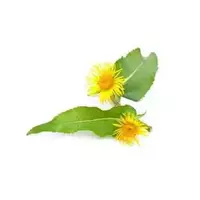Devyasil

Devyasil belongs to the genus of perennial herbaceous plants from the family Asteraceae, and today at least two hundred of its species are known. However, the most important for a person (both for medical purposes and in cooking) is a subspecies called the high maiden.
In general, the virgin tree is a plant, the height of which reaches one and a half to two meters. It is characterized by golden yellow flowers collected in large baskets, a thick rhizome of dark brown color and large oblong-ovate felt leaves. The roots and rhizomes of the girdle are distinguished by a peculiar smell, and the fruits of this plant are oblong achenes with a brownish crest. As a rule, in July - September it blooms, and fruiting is observed in August - October.
It is worth noting that the girdle is rather unpretentious - this plant is found along the banks of lakes and rivers, in moist meadows, in thickets of shrubs, pine forests and deciduous forests. Especially widely distributed in the European part of Russia, as well as Central Asia, Western Siberia and the Urals.
It is noteworthy that the Russian name of this plant is due to the fact that in ancient times it was customary to use it "against nine ailments" - hence the devil. In addition, today it is known by other names, including alant, yellow, elena grass, divochil, divosil, wild sunflower, somnite, oman meadow, yellow button, animal grass, rough grass and bear ear. In the composition of the devil, interestingly, a polysaccharide called inulin was first discovered - it is used as a starting material for the industrial manufacture of fructose.
For culinary purposes, the special aromatic properties of the maiden allow it to be used as a spice in the preparation of vegetable soups and dietary first courses. In addition, devyasil is often added to red sauce and oat porridge. This plant gives a rather pleasant aroma to drinks, apple compotes, sweet puddings and confectionery. In addition, independent dishes can be prepared from this plant: jelly or roots boiled in sugar.
In many countries of Europe and the USA, the devyasila root with the predominant tones of mint is used for fragrance of sweets, in the production of food concentrates and canned food, as well as in the liquor industry. By the way, the root of the plant has a dyeing effect (gives a blue color), and therefore its use in the relevant industrial industries is possible.
The composition of the devil
Vitamins K and E, as well as minerals such as magnesium, manganese, potassium, iron and calcium, were found in the girdle. As is known, the healing properties of devyasil are enclosed in the fact that this plant has an anti-inflammatory, exhalating, choleretic and weak diuretic effect. In addition, devyasil helps to increase bile elimination.
Devyasila 15 kKal
Energy value of devyasil (Ratio of proteins, fats, carbohydrates - ju):
Proteins: 2.9 g (~ 12 kCal)
Fats: 0 g (~ 0 kCal)
Carbohydrates: 0.2 g (~ 1 kCal)
Energy ratio (bj | y): 77% | 0% | 5%
 Español
Español Français
Français Português
Português Русский
Русский 简体中文
简体中文 繁體中文
繁體中文 日本語
日本語 한국어
한국어 العربية
العربية Türkçe
Türkçe Қазақ
Қазақ Deutsch
Deutsch Italiano
Italiano Українська
Українська
